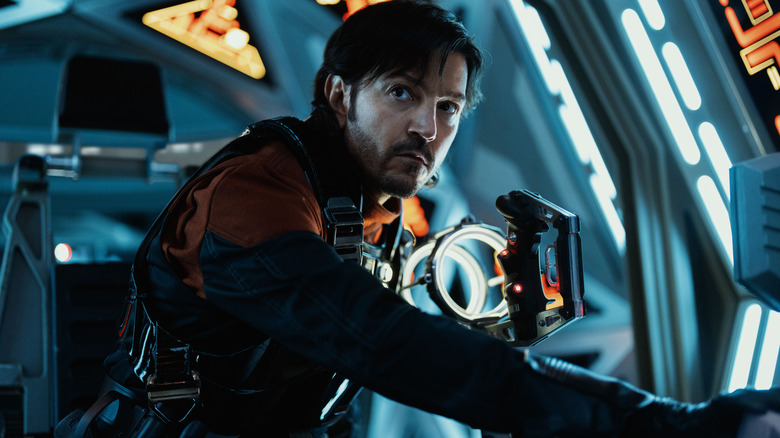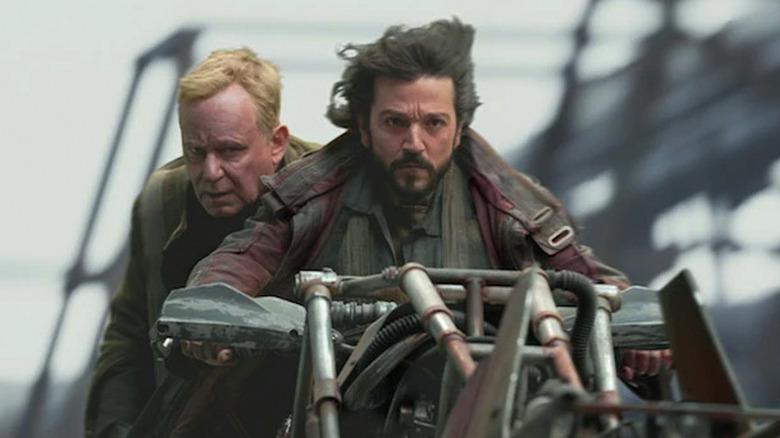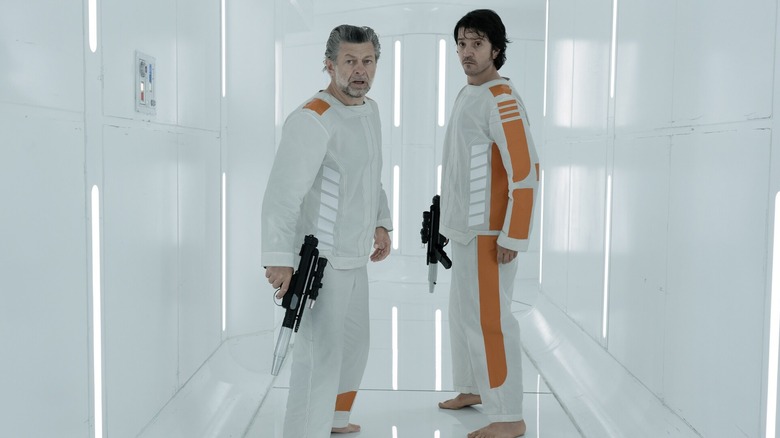Why Andor's Showrunner Cancelled The Star Wars Show's 5-Season Plan
We are approaching 13 years since George Lucas sold Lucasfilm to Disney for $4.05 billion. For better or worse, critics and fans continue to debate whether or not Lucasfilm president Kathleen Kennedy has been successful in her stewardship of the "Star War" franchise since then. To quote an elderly Obi-Wan Kenobi (Alec Guinness) regarding the discourse, "You will never find a more wretched hive of scum and villainy." However, at least one piece of "Star Wars" media has received universal acclaim: "Andor."
A spinoff prequel series to "Rogue One: A Star Wars Story," the first season of "Andor" centered on the earlier adventures of Cassian Andor (Diego Luna), a thief and scavenger whose tumultuous experiences eventually turn him into a revolutionary and lead him to join the Rebellion. Season 1 is set five years before Cassian joins the deadly mission to retrieve the Death Star plans on Scarif, and explores the year when he gets radicalized against the Empire.
Tony Gilroy, the credited co-writer of "Rogue One" who oversaw the film's extensive reshoots, is the creator and showrunner of "Andor." Gilroy originally intended the series to unfold across five seasons, with each of them exploring a different year in the titular protagonist's life. The slow-burn nature of season 1 was widely praised for being a remarkable showcase of maturity and political intrigue that no other "Star Wars" film or TV series has ever had. However, season 2 is now set to conclude the series, with 12 episodes slated to be released within four chapters through three-episode arcs, each taking place within the last four years before the battle on Scarif and the events of "Star Wars: Episode IV — A New Hope." Although this is a shift from their original plans, Gilroy and Lucasfilm have their reasons.
The approach to Andor changed out of 'desperation'
Part of what made "Andor" season 1 such compelling television was its massive scope, especially when compared to its counterpart shows such as "The Mandalorian" (the latter of which is notable for its extensive use of Lucasfilm's StageCraft technology, which Tony Gilroy avoided in favor of utilizing real sets). Given the incredible scale in which the first season was produced, along with much of it being set back multiple times due to the pandemic, Gilroy revealed to SFX that the shift from his original five-season plan was "born out of desperation." As he put it:
"We were halfway through shooting season 1, coming through Covid, and the monumental size of the show, the effort, and everything else was just dawning on us. We realized that I didn't have enough calories to do it, and Diego's face couldn't take the timing, because it just takes too long to make it. We were saved by Disney saying, 'Okay, if you guys can figure out a way to do it, we're into it ... It's a fascinating experiment and I don't know if anyone's ever done it before. We're going to jump a year between each block, and we're going to use that negative space in a really interesting way, coming back for three days at a time, so it's like a Thursday, Friday, Saturday, or a Monday, Tuesday, Wednesday."
Gilroy's updated approach to "Andor" makes total sense, given that it has been nearly three years since the first season dropped. The laborious production and skyrocketing budget of "Andor" likely took a toll on him, Diego Luna, and the rest of the cast and crew. Indeed, as exciting a prospect as it would have been to see "Andor" told through a five-season run, perhaps it was best for everyone that the final four chapters to be told within season 2 are, in a way, four "Star Wars" films made for prestige television. That way, the show's creative team can conclude the series on their terms without having to half-ass four seasons that would've likely left all concerned parties exhausted.
Andor remains a shining beacon in an oh-so-polarizing era for Lucasfilm
Many would agree that the current state of the "Star Wars" franchise is a hot mess. For nearly six years, the galaxy far, far away has been relegated to Disney+ exclusive television shows, and no films have been released since 2019's "Star Wars: Episode IX — The Rise of Skywalker." Sure, we have "The Mandalorian & Grogu" set to hit theaters on May 22, 2026, but that is explicitly tied to the streaming series it is based on. And following the middling third season of "The Mandalorian," as well as a slew of underwhelming projects such as "The Book of Boba Fett," "Obi-Wan Kenobi," and "The Acolyte," Disney's second-biggest intellectual property is in desperate need of unambiguous wins. Thankfully, "Andor" is, in fact, exactly that.
The first season of "Andor" is far and away the most critically acclaimed "Star Wars" project in many years, garnering eight Primetime Emmy nominations, including Outstanding Drama Series. If Tony Gilroy and company manage to stick the landing with season 2, the series will be permanently solidified as one of the most definitive "Star Wars" stories ever told. Either way, season 1 has already set such a high standard for the franchise that it feels nearly impossible to uphold, given Lucasfilm's mixed reputation within the Disney era. With Kathleen Kennedy expected to leave her position by the end of 2025, hopefully, her predecessor will find inspiration from the sheer brilliance of "Andor" and encourage the creatives behind other "Star Wars" series and films to follow Gilroy's lead.
The second and final season of "Andor" is set to premiere on Disney+ on April 22, 2025.


